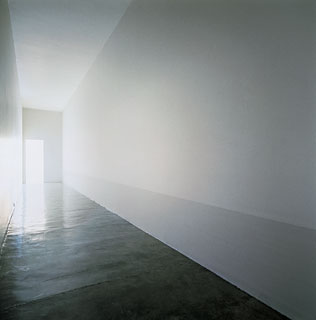 Robert Irwin, Varese scrim, 1973
Robert Irwin, Varese scrim, 1973I've been thinking about the artist Robert Irwin (whose recent show at Pace Wildenstein Strath wrote about here) a lot lately. Irwin is one of those artists for whom I have complete respect — even awe. He has steadfastly followed his artistic conscience wherever it's taken him, no matter the consequences. That conscience led him away from the canvas, and finally even away from his studio, which he dismantled, disposing of the contents in the early 1970s, with no clear idea of what would come next. What did ensue was a complete rejection of the idea of art as object, and the development of the concept of art as a process of perception, intended to deliver awareness of aspects of our environment that we would otherwise ignore.
 Five views of Robert Irwin's Scrim veil — Black rectangle –
Five views of Robert Irwin's Scrim veil — Black rectangle –Natural light, Whitney Museum of American Art, 1977
Irwin had a retrospective at the Whitney in NYC 32 years ago, in the late spring of 1977. Writing about the show in his fascinating biography of Irwin, Seeing is Forgetting the Name of the Thing One Sees, author Lawrence Weschler explains:
Irwin used his museum pieces to raise questions that were then aimed at the surrounding world into which the major work had already broken out. Lovely as it was, Irwin's Whitney installation was primarily intended to function as a catalyst . . . . The great floating rectangle and the way it in turn brought out the modulation of the ceiling and the reticulation of the floor established the predominant theme of the grid; and just as many museum visitors experienced, as if for the first time, the hegemony of right angles within the room, so they were now invited to translate this reclaimed vision out into a city where the grid of clean horizontals and verticals is so pervasive as to have become almost invisible. Beyond that, the room seduced the sympathetic observer into a certain attitude of perception, a posture of heightened attention, and this heightened vision was in turn available for transposition into the world. Walking out of the musuem onto Madison Avenue, Sotheby Parke Bernet diagonally across the street looked different from the way it ever had before; both it and the look had been reclaimed.The catalog for the Whitney retrospective included photographs of two on-site installations by Irwin, each followed by photographs of an unmediated environmental effect; for instance, a photo of Irwin's "Black plane — Fifth Avenue and 42nd Street" (in which Irwin painted black the square demarcated by the crosswalks at that intersection) was followed by a photo taken from a helicopter, titled "Black planes — Shadows, Park Avenue," in which, in Weschler's words, "Park Avenue is revealed as a succession of black building shadows and thin strips of intervening sunlight." Of the implication of these photographic juxtapositions, Weschler observes,
And that, of course, was just about as far as you could go on a particular line of aesthetic inquiry, for it implied not only the dematerialization of the art object, but the virtual evaporation of the artist's role qua artist. And Irwin was willing to say as much. Sitting there in the Whitney's coffee shop, Irwin pointed through the glass wall up at the play of shadows on a building facade across the street. "That the light strikes a certain wall at a particular time of day in a particular way and it's beautiful," he commented, "that, as far as I'm concerned, now fits all my criteria for art."Weschler concludes, "at the terminus of Irwin's trajectory, when all nonessentials had been stripped away, came the core assertion that aesthetic perception itself was the pure subject of art. Art existed not in objects but in a way of seeing."
 The cover of Irwin's 1977 Whitney Museum exhibition catalog
The cover of Irwin's 1977 Whitney Museum exhibition catalogI think having Irwin on the brain lately has something to do with being back in the Northwest — not necessarily because Irwin is from the West Coast, but because there is so much more space here in which to see, and I'm consistently aware of my surroundings in a way that I wasn't on the East Coast (as beautiful as New York is). There have consequently been a few times lately when I've read a description of an artist's work as evoking or referencing this or the other natural feature or architectural idea, or causing one to think of x, y, or z thing in the physical world outside the gallery. And more than a few times my reaction has been not, 'oh, that's interesting,' but instead, 'well why isn't that thing that we're being asked to consider the real art object?' Of course, art often has the goal and effect of causing a viewer to look differently at people, objects, or surroundings. But Irwin bravely took this idea to places that no artist of whom I'm aware had gone before, and I think I have him to thank for this question.
Art critic Roberta Smith asserted in 1976: "Duchamp bluntly illustrated that any object could be art if so called. Irwin's work has been suggesting, with increasing insistence, that any situation is art, if so experienced." I think this is as good an explanation as any for why I've never felt a need for spiritual enlightenment that couldn't be satisfied by a walk in the woods or some time by the water (or even contemplating a manmade object as beautiful and strange as the Space Needle or Chrysler Building or as mundane as a crumbling barn in the middle of a green field). That's my church, and it's more than enough.
 Drew Smith, untitled (Pacific Ocean)
Drew Smith, untitled (Pacific Ocean)Buy Seeing is Forgetting here (or borrow it from your local library), and watch a short documentary on Robert Irwin here.